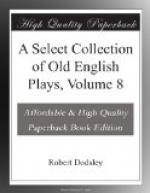[146] These words, which are clearly a stage direction, and which show how mere a child delivered the Epilogue, in the old copy are made part of the text.
[147] Malone originally supposed the plays to be by Heywood, and so treated them. In the last edit. of Shakespeare by Boswell (iii. 99) the mistake is allowed to remain, and in a note also “The Downfall of Robert Earl of Huntington” is quoted as Heywood’s production.
[148] Ritson, in his “Robin Hood,” I. li. et seq., gives some quotations from them, as by Munday and Chettle.
[149] Mr Gifford fell into an error (Ben Jonson, vi. 320) in stating that “The Case is Altered” “should have stood at the head of Jonson’s works, had chronology only been consulted.” In the “Life of Ben Jonson,” he refers to Henslowe’s papers to prove that “Every Man in his Humour” was written in 1596, and in “The Case is Altered,” Ben Jonson expressly quotes Meres’ “Palladia Tamia,” which was not published until 1598. Nash’s “Lenten Stuff,” affords evidence that “the witty play of ’The Case is Altered’” was popular in 1599.
[150] On the title-page of his translation of “Palmerin of England,” the third part of which bears date in 1602, he is called “one of the Messengers of her Majesty’s Chamber;” but how, and at what date he obtained this “small court appointment,” we are without information. Perhaps it was given to him as a reward for his services in 1582.
[151] Munday did not always publish under his own name, and according to Ritson, whose authority has often been quoted on this point, translated “The Orator, written in French by Alexander Silvayn,” under the name of Lazarus Piot, from the dedication to which it may be inferred that he had been in the army. “A ballad made by Ant. Munday, of the encouragement of an English soldier to his fellow mates,” was licenced to John Charlewood, in 1579.
[152] [See the more copious memoir of Munday by Mr Collier, prefixed to the Shakespeare Society’s edit. of his “John-a-Kent,” &c., 1851.]
[153] That is, no printed copy has yet been discovered, although it may have passed through the press.
[154] In Henslowe’s MSS. this play is also called, “The First part of Cardinal Wolsey.”
[155] In 1620 was printed “The World toss’d at Tennis, by Thomas Middleton and William Rowley.” Perhaps it is the same play, and Munday had a share in the authorship of it. [This is not at all probable.]
[156] There is no list of characters prefixed to the old copy.
[157] This forms the Induction to the play, which purports to have been written to be performed before Henry VIII., by Sir Thomas Mantle, who performed Robin Hood, by Sir John Eltham, who played the part of Little John, by Skelton, who acted Friar Tuck, by “Little Tracy,” as he is called, who supported the character of Maid Marian, and others, whose names are not mentioned. The whole is only supposed to be a rehearsal prior to the representation of the piece before the king, and in the course of it Skelton and Sir John Eltham have various critical and explanatory interlocutions. Skelton, it will be observed, also undertakes the duty of interpreting the otherwise “inexplicable dumb-show.” The old copy is not divided into acts and scenes.




